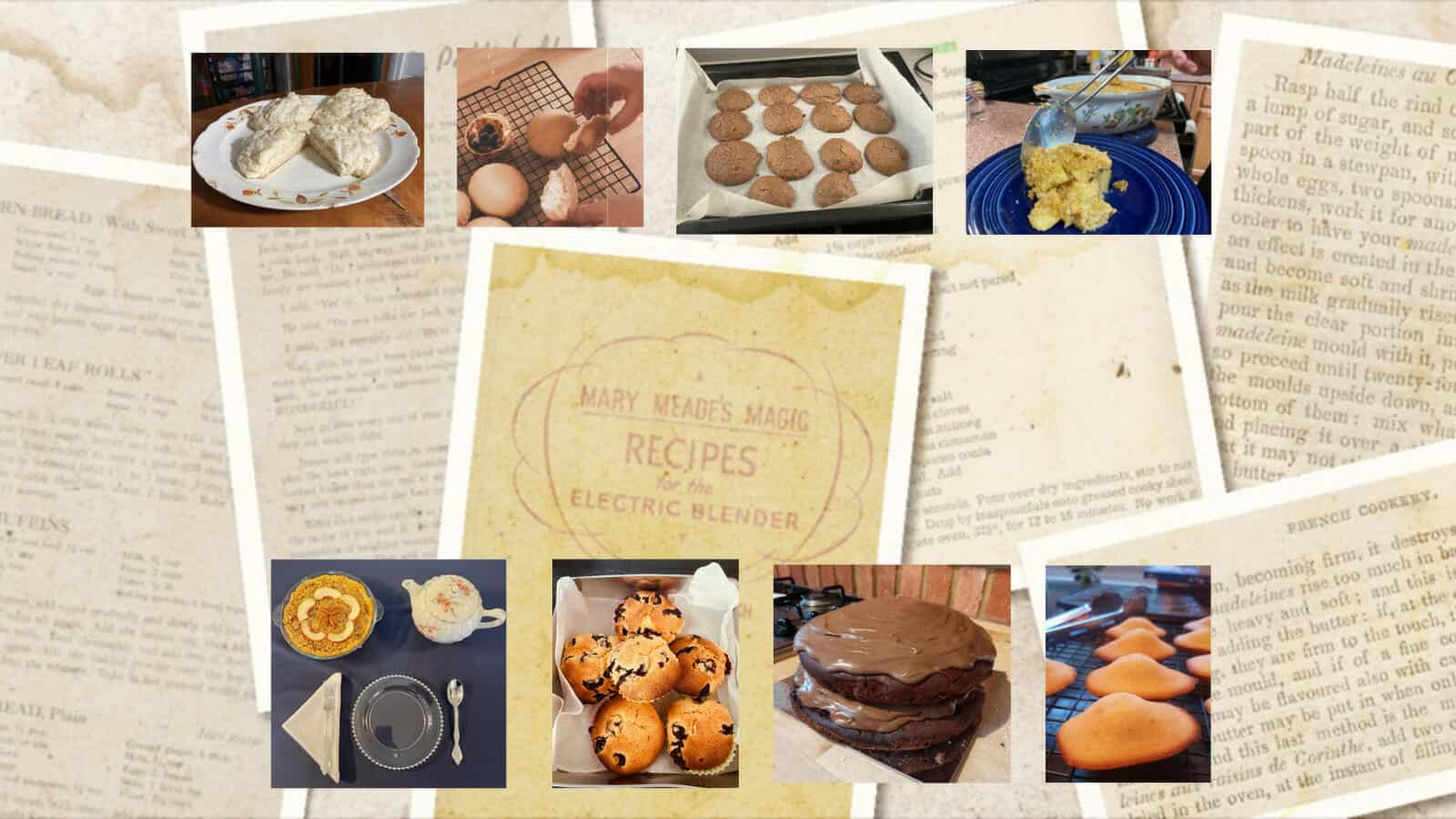│By Lucy Dow, Associate Acquisitions Editor and Cheryl Moody, Marketing Manager│
The recently published Archives Unbound collection Food History: Printed and Manuscript Recipe Books 1669-1990 contains 36 manuscript recipe books and 328 printed recipe books from the Winterthur Library and Museum in Delaware. The majority of the books are in English, with a few in French and German. The published volumes come from the UK, USA, France and Germany; the manuscript volumes are, most likely, from the UK and USA.
Thrilled to be releasing this exciting new archive collection, we ran a historical baking competition between Gale staff in which the unique and illuminating primary sources piqued the interest of colleagues in numerous departments within Gale. And thus arose Gale’s inaugural Food History Bake Off!
Recipes and Cookery Books as Historical Sources
When Lucy was writing her PhD on eighteenth- and nineteenth-century British cookery books she came to realise that, perhaps more than any other historical source, cookery books give us a sense of the lived experience of the past. The Archives Unbound collection, with its wide geographical scope and three-hundred-year time span, most obviously charts how tastes changed over time. But cookery books tell us so much more than that! They are often uniquely placed to give us an insight into how people’s life stories and personal histories make up larger historical narratives.
• Peach Pecan Pie (1967)
We can see this in relation to the winning entry in Gale’s Food History Bake Off – a recreation of a 1967 recipe for Peach Pecan Pie from Rene Verdon’s The White House Chef Cookbook. In the acknowledgements to his book, Verdon thanks a friend for his help with writing the book as “I am a relatively new American, and English is not my native language” (pg. 7). Verdon, an economic migrant to the US, was part of a wave of post-WWII European migration to the USA. His recipes are a reflection of his culinary training in France and his experiences of working in the USA. As Verdon himself explains, “While many of the dishes are classic French preparations, all of them are quite workable in the average American kitchen, and I have been careful to make them so” (p. 17).
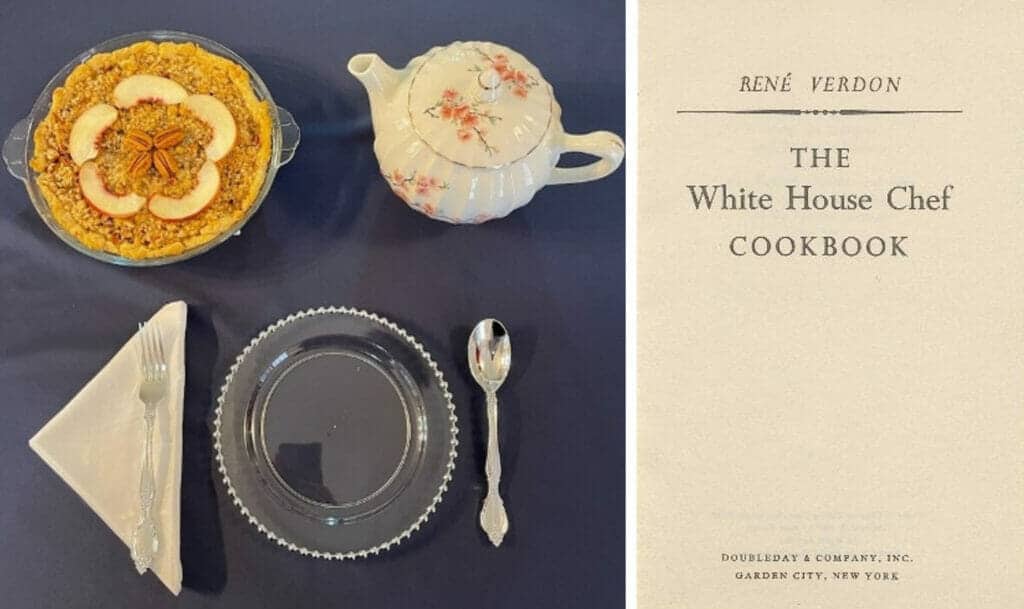
Verdon, Rene. The White House chef cookbook / Rene Verdon. Doubleday, c1967. Archives Unbound, https://link.gale.com/apps/doc/ZBYDFU098653405/GDSC?u=gale&sid=bookmark-GDSC&xid=e64afa30&pg=8
• Blueberry Muffins (1941)
Recipes are also unique as a form of writing which has been largely created and developed by female authors. Another contestant in Gale’s Food History Bake Off used a blueberry muffin recipe from The Way to His Heart (1941), a “book of recipes [that] has been compiled by five cooks, representing three generations of one family, aided by their friends and relatives” (p. 3).
The opening pages of the book recount a series of letters exchanged between the five female cooks. This gives an unusually detailed account of how the book came into being, starting with a letter from one of the recently married younger women requesting help with cooking from her mother and grandmother. Through this exchange, and the book it generated, we see how cookery books, printed and manuscript, were places where women recorded knowledge and communicated information of all kinds.
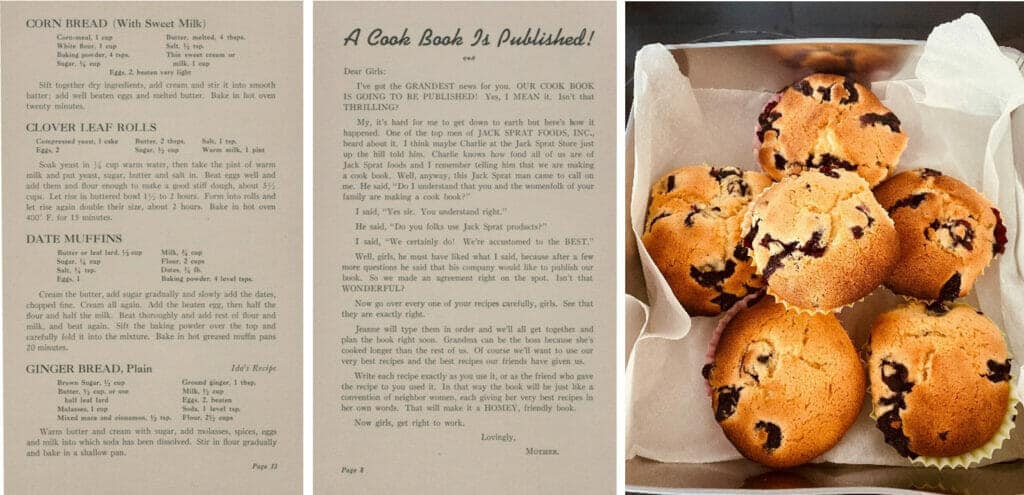
The Way to his heart: a cook book with a personality / editor, Priscilla Wayne Sprague. Western Grocer Co., ©1941. Archives Unbound, https://link.gale.com/apps/doc/ZCQUXM988556944/GDSC?u=webdemo&sid=bookmark-GDSC&xid=1edb28ec&pg=1
• New Year’s Cake (1841)
Another top entry in Gale’s Food History Bake Off was New Year’s Cake, a kind of scone, which came from the mid-nineteenth-century American cookery book The kitchen directory and American housewife (1841), written by an anonymous female author. Comparing this recipe to the blueberry muffins recipe mentioned above, we can see how the cookery books in the Archives Unbound collection reveal much about technological change, and particularly technology in the home.
A noticeable difference between the two recipes can be found in the instructions for baking the cakes. The older recipe instructs the user to “bake them of a pale brown, in an oven of equal heat throughout” whilst the newer recipe explains the muffins are to be baked in a “hot oven (425° F.) 25 minutes.” These two precise details, given in specific units of measurement, speak to a kitchen and cook that has an oven with a thermostat and an accessible way of measuring time in minutes. These kinds of technological developments had been so thoroughly incorporated into American domestic life by the mid-twentieth century as to be thought ordinary and mundane.
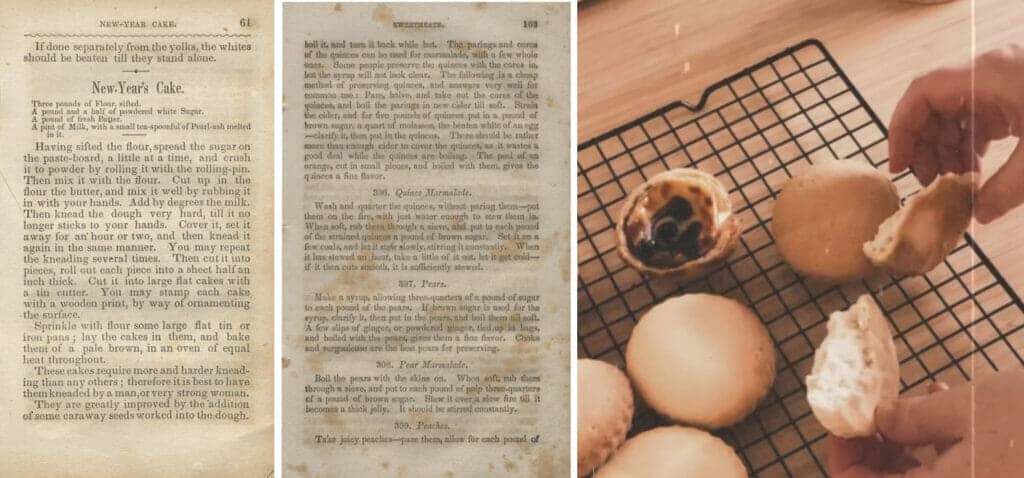
New Year’s Cake: Leslie, Eliza. Miss Leslie’s seventy-five receipts for pastry, cakes and sweetmeats / By Miss Leslie of Philadelphia. 20th ed., Munroe & Francis, 1851. Archives Unbound, https://link.gale.com/apps/doc/ZCXIGO811272150/GDSC?u=webdemo&sid=bookmark-GDSC&xid=9b7cb5ee&pg=65
Pear Marmalade: The kitchen directory and American housewife: containing the most valuable and original receipts in all the various branches of cookery …. Mark H. Newman & Co., 1841. Archives Unbound, https://link.gale.com/apps/doc/ZCPEXM045959839/GDSC?u=webdemo&sid=bookmark-GDSC&xid=5c1fdb91&pg=109
The Remarkable Stories Behind our Chosen Recipes
To truly appreciate the significance of cookery books as reflections of their time and place, we must delve into the rich tapestry of food history, a narrative woven from threads of culture, tradition, and innovation.
What better way to explore these archives than by organising a baking competition? With the extensive archives of Food History: Printed and Manuscript Recipe Books encompassing works from 1669 to 1990, we embarked on a journey through time and flavour.
Alongside the winning entries described above, many other colleagues presented us with fantastic entries and shared the remarkable stories behind their chosen recipes.
• Madeleines (1836)
Adeline’s story: Recently, I experienced a Proustian moment, filled with nostalgia and homesickness, inspiring me to bake madeleines. With my new madeleine baking tray in hand, I tackled a wordy 1836 recipe. Despite modern oven adjustments (12 minutes at 200°C, as opposed to the recommended 25-30 minutes), the result was splendid. Preserving butter at the moulds’ bottom, as advised, yielded delicious, glazed petites citron-flavoured madeleines. They stayed soft and delightful for days, perfect for dipping into a cup of tea—a true delight for madeleine enthusiasts!
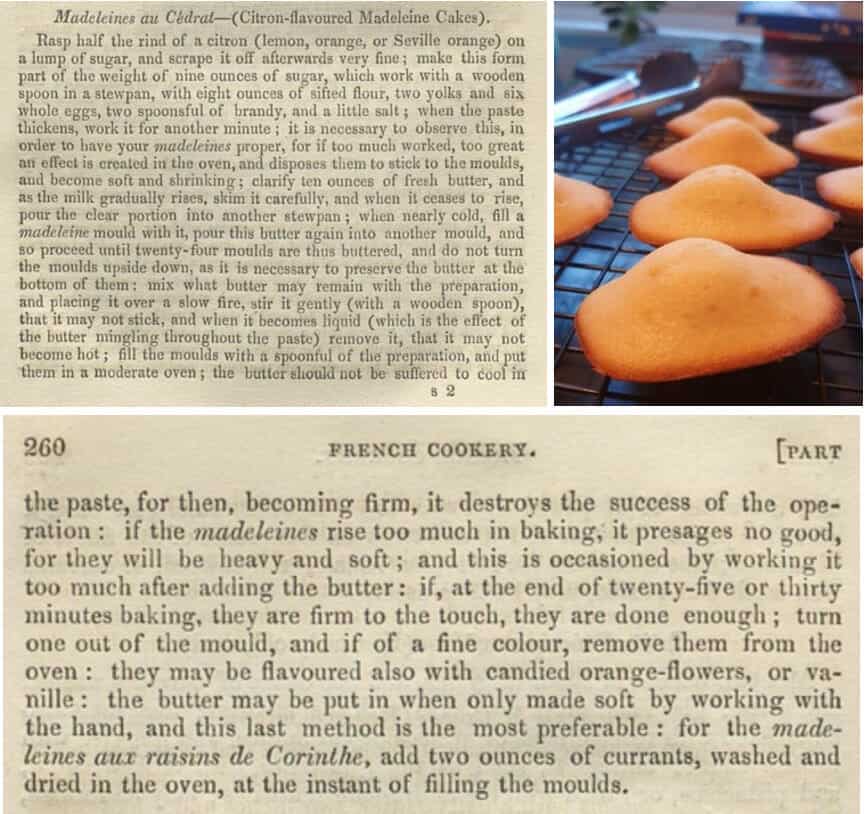
Careme, Marie Antonin. French cookery: comprising L’art de la cuisine francaise, Le patissier royal, Le cuisinier parisien / by the late M. Careme translated by William Hall with seventy-three plates illustrative of the art. J. Murray, 1836. https://link.gale.com/apps/doc/ZECFNN380861423/GDSC?u=61adeline&sid=bookmark-GDSC&xid=4c30a586&pg=373
• Chocolate Cake (1926)
Jess’s story: With my dad’s birthday approaching, I delved into the archives for a special recipe. I settled on a chocolate cake recipe – but was stunned to find that the ingredients omitted a crucial component: chocolate! Fortunately, the instructions called for “melted chocolate,” so I improvised. I was drawn to the idea of Mocha Icing, something I hadn’t tried before. Combining coffee and chocolate in the icing turned out to be an innovative addition to the cake. The result? Surprisingly delicious!
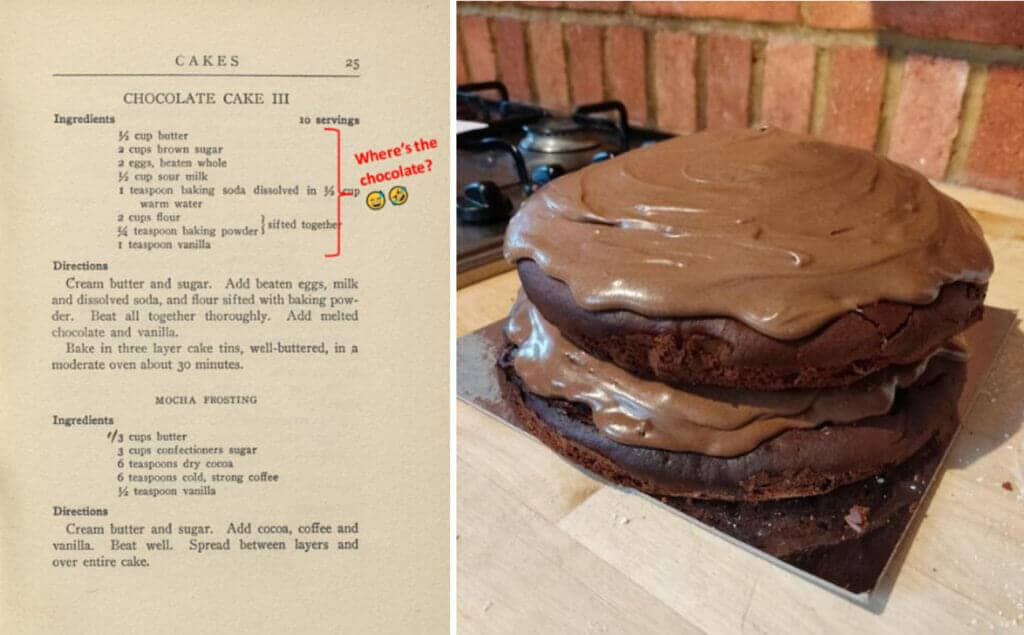
Alexander, Helen. The Helen-Alexander cook book. Maddox & Gray, c1926. Archives Unbound. https://link.gale.com/apps/doc/ZCTWZR121297490/GDSC?u=webdemo&sid=bookmark-GDSC&xid=0b503137&pg=37
• Apple and Bread pudding (1846)
Phil’s story: As fall approached and my very old apple tree had a bumper crop of apples, it seemed appropriate to choose a recipe with apples in it. Scouring the manuscripts I found an Apple & Bread Pudding recipe. The ingredients were simple: 3/4 of a pound of breadcrumbs, 1 1/2 pounds of apples, sugar, and butter. For bread, I had some leftover Pulla (Finnish cardamom bread) my mother had made. I used mostly brown sugar mixed with a little white sugar. For the butter, I used salted butter. The recipe calls for layering butter, apples/sugar, and breadcrumbs. A pat of butter goes on top for good measure.
My daughter Leea and I put everything together under the watchful eye of our sous-chef dog Candy. The recipe called for a moderately hot oven (we chose 350 degrees), but did not indicate how long to bake it. We decided to wait until the breadcrumbs on top began to brown up and the filling began to bubble, which turned out to be about 45 minutes. The apple/sugar/breadcrumb filling paired nicely with the slight crunch of the breadcrumb crust on top.
Leea and I both sampled the dish and declared it delicious. Leea noted it would be even better with vanilla ice cream. Although a simple recipe, picking and preparing the apples did take some work. I would definitely make this recipe again, perhaps adding cinnamon and maybe a little rum.
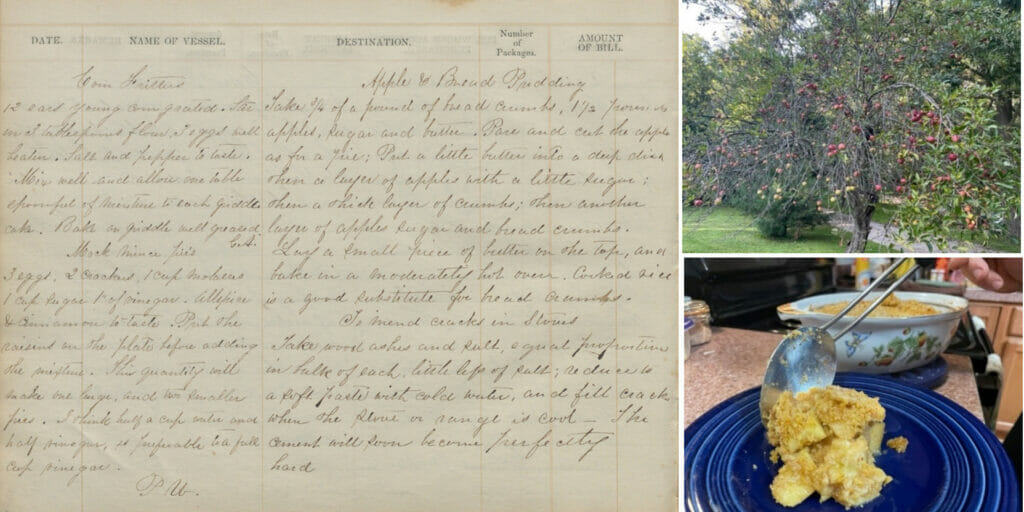
Sanborn, Lydia S. Recipe Book, 1846. 1846. MS Food History: Printed and Manuscript Recipe Books, 1669-1990 Doc. 953, 94×138. Winterthur Museum. Archives Unbound, https://link.gale.com/apps/doc/UUUWXB977574946/GDSC?u=virta&sid=bookmark-GDSC&xid=11440be5&pg=99
• Potato Biscuits (1954)
Anne’s story: Shakers, a near-extinct religious group, piqued my interest through their famous hymn “Simple Gifts,” learned in choir class as a child. A 1995 Girl Scout trip to the Shaker Village Museum in Kentucky deepened my understanding of their lifestyle. In 2014, I introduced my new family to the same place and had the rare opportunity to converse with one of the last living Shakers, Brother Arnold Hadd, at Sabbathday Lake Shaker Village in Maine last summer.
Exploring the Food History archive, I eagerly delved into the “Recipes of the Shakers” cookbook from 1954, originating at the Shaker Village Work Camp in Massachusetts. Its charming hand-drawn illustrations added to its allure. While I initially aimed to bake Shaker bread (I adore working with yeast dough), the mention of retaining wheat germ in flour milling intimidated me. Unsure of a suitable store-bought replacement, I discovered a Potato Biscuits recipe—blending bread and mashed potatoes.
The outcome was satisfying, especially with a dollop of butter and milk added. My attempts to roll the dough were unsuccessful, leading me to shape them as drop-biscuits. They baked for approximately 15 minutes until golden. Next time, I’ll opt for smaller sizes, as there will undoubtedly be a next time.

Recipes of the Shakers, 1954. Shaker Village Work Camp, [1954]. Archives Unbound, https://link.gale.com/apps/doc/ZDJSCF486405763/GDSC?u=anagrant_acd&sid=bookmark-GDSC&xid=a1525a14&pg=80
• Oatmeal Apple surprises (1952)
Nicholas’s story: A simple but chocolatey oatmeal biscuit which packed a punch with an infusion of cloves, nutmeg and cinnamon. First time I’d ever cored an apple (!) and worked out what baking at 375 F meant for a UK fan oven! I also worked out for the first time what the difference between rolled oats and porridge oats were. A delicious education all round! To be honest, I got addicted to the mix before it hit the oven it was so yummy – post-bake the cookies were good, but not as flavoursome as the pre-baked cookie goo. However, a nice complement to a cup of tea on an autumn/fall afternoon.
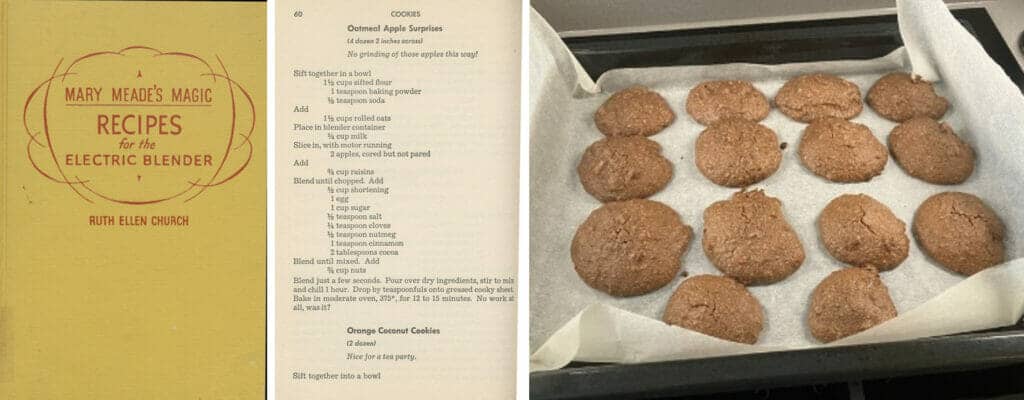
Church, Ruth Ellen. Mary Meade’s magic recipes for the electric blender / by Ruth Ellen Church. Bobbs-Merrill, c1952. Archives Unbound, https://link.gale.com/apps/doc/ZCWHZK204792103/GDSC?u=webdemo&sid=bookmark-GDSC&xid=ec18b282&pg=1
A Delightful Celebration of Culinary History
Our baking competition was a delightful celebration of culinary history, skill, and creativity. Each entry served as a window into a unique story, a taste of heritage, and a reminder of the profound impact food has on our lives. The primary sources within Food History: Printed and Manuscript Recipe Books, 1669-1990 proved to be a rich source of inspiration.
If you enjoyed reading about the fantastic recipes available in this Archives Unbound collection, you may like:
- ‘I Scream, You Scream, We All Scream for Ice Cream!’ Ice Cream Recipes in Eighteenth Century Collections Online
- “Even the Sacramental Cup Was Not Exempt from Adulteration” – The Hazards of Drinking an Old Bottle of Claret
- Researching and Teaching Women Writers Using Eighteenth Century Collections Online
- The Development of the British Palate, Part 1
- The Development of the British Palate, Part 2
- Elbows off the table
Blog post cover image citation: A montage of recipes found within this blog post.

